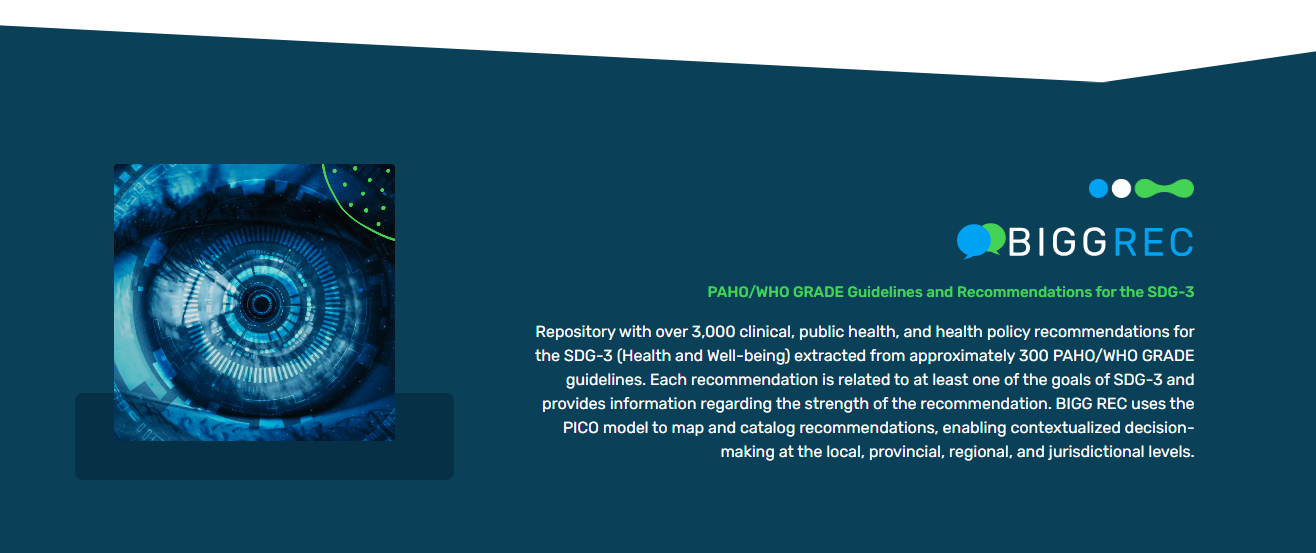A new online portal has been launched by the Latin American and Caribbean Center on Health Sciences Information (BIREME) in collaboration with the Pan American Health Organization/World Health Organization (PAHO/WHO) to facilitate access to the more than 5,000 guidelines and recommendations produced by these organizations. The “GRADE Guidelines and Recommendations” portal now integrates the three main resources for accessing this type of information, which were previously available on separate websites: the GRADE International Guidelines Base, the PAHO and WHO Recommendations for SDG-3 Guides and Guidelines, and the Interactive Maps of Pharmacological Recommendations for COVID-19.
The Grading of Recommendations Assessment, Development, and Evaluation (GRADE) system is a standardized and transparent method for assessing the quality of evidence and the strength of recommendations in public health. Used by PAHO, WHO and more than 110 other organizations around the world, the GRADE approach establishes best practice requirements for the development and reporting of guidelines, ensuring a focus on issues important to decision-makers and the formulation of appropriate recommendations. In other words, its use can help ensure that clinical and public health practices are based on robust evidence, contributing to better health outcomes and the effectiveness of health systems around the world.
However, “the guidelines and their recommendations are often not indexed and can be difficult to find, which threatens the extent of their use,” says Veronica Abdala, BIREME’s Product and Information Sources Manager. Therefore, the new portal not only “facilitates integrated access to GRADE lists of guidelines, recommendations, and evidence maps, but is also a product that contributes to PAHO’s ongoing efforts to stimulate the use of health-related evidence and promote evidence-based decision-making and policymaking.”
Previously, the resources were available on three different websites: the BIGG Database, BIGG-Rec and BIGG-Map (see Table for details). “Each of these resources provided specific information for the GRADE standard-based clinical guidelines and practices, the recommendations aligned with the Sustainable Development Goals (SDGs), and the interactive maps of the pharmacological recommendations for COVID-19. However, this separation made it difficult to access and navigate for users interested in exploring all available options,” Veronica noted.
With the launch of BIGG, the three features have been integrated into a single platform, providing a more fluid and efficient experience for users. Now, healthcare providers, managers, and researchers can access a search box in the main interface, in addition to exploring the BIGG and BIGG-Rec sections, which include recommendations aligned with the SDGs, and accessing the GRADE Maps in a simplified way.
The solution is now available online, allowing users to quickly access up-to-date and reliable information on clinical practices and health recommendations. The launch of the portal is the result of a coordinated effort between PAHO/WHO and BIREME, in collaboration with the Epistemonikos Foundation.
| Table: Description of the information resources of GRADE Guides and derivatives |
| BIGG – International Database of GRADE Guidelines
Clinical and Public Health Guides and Guidelines: A collection of selected and evaluated clinical and public health guidelines based on the GRADE approach – Grading of Recommendations, Assessment, Development, and Evaluations. There are over 2,000 guidelines published by WHO, PAHO and other national and international health institutions. |
| BIGG-Rec – PAHO/WHO GRADE Recommendations for the SDGs-3
Repository with over 3,000 clinical, public health and health policy recommendations for the SDG-3 (Health and Well-Being) extracted from approximately 300 PAHO/WHO GRADE guidelines. Each recommendation is related to at least one of the goals of SDG-3 and provides information regarding the strength of the recommendation. BIGG REC uses the PICO model to map and catalog recommendations, enabling contextualized decision-making at the local, provincial, regional, and jurisdictional levels. |
| BIGG-Map – A comprehensive repository of COVID-19 recommendations
BIGG MAP is an interactive map of medical recommendations that is displayed in the form of a matrix, where each resulting box is the intersection between a population and a type of intervention. Each box on the map indicates the number of recommendations consisting of 4 dimensions given by strength and direction. |
Links of interest:



